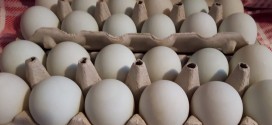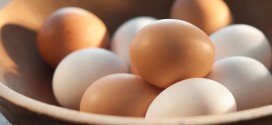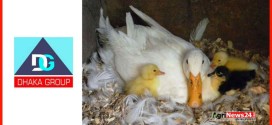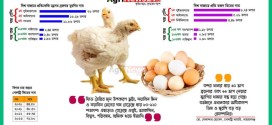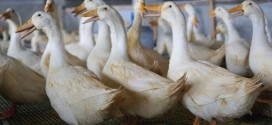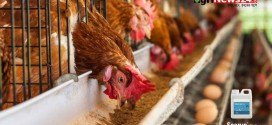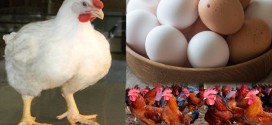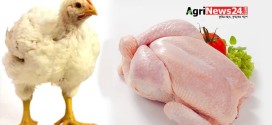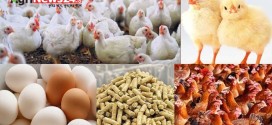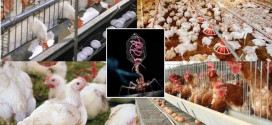 In the context of reducing in-feed antibiotics, there is a need for natural, profitable and proven solutions for poultry production. Probiotic bacteria, which exert a positive effect on the digestive microflora balance and gut development, can help improve laying performance.The lactic acid bacteria strain Pediococcus acidilactici MA 18/5M,producing a high level of lactic acid,is one of the most studied probiotic bacteria with more than 40 scientific publications in monogastric feeding. Its modes of action are well-documented. This is confirmed by results obtained in farms and trials in commercial settings, which consistently show benefits on laying performance, in particular through an improved laying rate and better feed conversion. In addition, probiotic benefits lead to improved poultry survival and egg quality, representing significant benefits for producers.
In the context of reducing in-feed antibiotics, there is a need for natural, profitable and proven solutions for poultry production. Probiotic bacteria, which exert a positive effect on the digestive microflora balance and gut development, can help improve laying performance.The lactic acid bacteria strain Pediococcus acidilactici MA 18/5M,producing a high level of lactic acid,is one of the most studied probiotic bacteria with more than 40 scientific publications in monogastric feeding. Its modes of action are well-documented. This is confirmed by results obtained in farms and trials in commercial settings, which consistently show benefits on laying performance, in particular through an improved laying rate and better feed conversion. In addition, probiotic benefits lead to improved poultry survival and egg quality, representing significant benefits for producers.
Higher laying performance: The results of multiple trials conducted in laying hens with probiotic Pediococcus acidilactici MA 18/5M(BACTOCELL®, Lallemand Animal Nutrition) have been compiled in order to evaluate the probiotic’s potential benefits for farm performance. The data and results were analysedfrom six different published trials conducted in research institutesand in commercial farmswith different housing systems, genetics and various supplementation duration.
 Depending on the trials, laying rate isincreased by 2 to 3.4%, while egg weight is also always increased (up to 2.8%), resulting in consistant increase of exported egg mass (from 0.6% for the shortest trial duration up to 5%)(Figure 1).
Depending on the trials, laying rate isincreased by 2 to 3.4%, while egg weight is also always increased (up to 2.8%), resulting in consistant increase of exported egg mass (from 0.6% for the shortest trial duration up to 5%)(Figure 1).
Statistical analysis were performed on the results of four trials on a 24-week duration (from week 22 to 46). On average,P. acidilactici MA 18/5M significantly increased the laying rateby 2.8% (p<0.05) and exported egg mass by 3.5% (p<0.01), equivalent to an extra 13.1g of egg/hen/week, or 131 kg/ week for 10,000hens.
This effect is linked to improved feed utilization with the probiotic, as shown by an improved feed conversion rate (Figure 2). Similar statistical analysis indicate a reduced feed conversion rate equivalent to -0.07kg/kg.
In addition, trials typically show a positive effect on the laying curve. It is sustained and smoothened over the whole cycle. P. acidilactici MA 18/5M, supplemented during the whole cycle, improves laying persistence (Figure 3).Taking into account laying performance enhancements, the minimum return on investment for the producer is 3-to-1.
 Reducing mortality : Several trials have shown thatunder challenged conditions and high pathogen pressure, the lactic acid bacteria, thanks to its positive effect on the digestive microflora, helps control pathogen development and reduces mortality risks due to bacterial challenge.
Reducing mortality : Several trials have shown thatunder challenged conditions and high pathogen pressure, the lactic acid bacteria, thanks to its positive effect on the digestive microflora, helps control pathogen development and reduces mortality risks due to bacterial challenge.
This has been observed in many farm conditions. A production trial conducted in Morocco in 2011confirms this effect in commercial farming conditions (Figure 4). In this trial, at the end of the laying period (71 weeks), the cumulative mortality was 4.08% in the treated building vs. 4.92% in the control building; equivalent to 481 hens spared during the trial period.
In 2015, a French commercial trial gathering about 200 000ISABrown laying hens also showed a concomitant mortality reduction in two buildings independently receiving P. acidilactici MA 18/5M. In the first building (72 000laying hens), the hens were supplemented from 17 to 60 weeks of age, with a four week involuntary discontinuation (week 34 to 38). Following this disruption of the supplement, the mortality increased 2.5-fold (weekly mortality: 22 hens before vs. 56 after the probiotic disruption). In the same manner, after the end of the supplementation period (week 60), the mortality increased 2.9-fold (weekly mortality: 161 after the supplementation).
In a second building (119 000 laying hens), P. acidilactici MA 18/5M implementation followed a spur of mortality linked to colibacillosis outbreak at week 36 of age. The supplementation (from week 37 to 54) helped control the mortality; while, from week 54, when the supplementation stopped, weekly mortality rose again (weekly mortality 220 vs. 116).
Benefits have moreover been observed inAsian commercial farms carrying out forced molting. Reductions by half of the mean daily mortality have been reported.
This benefit is linked to the effects P. acidilactici MA 18/5M has on the control of pathogens development, in the gut and consequently on the barn environmentand the egg surface. Studieshave shown that P. acidilactici MA 18/5M shifts gut microflora toward a more balanced profile under challenging conditions, resulting in reduced Clostridium perfringens., Salmonella typhimurium., Salmonella enteriditis, Escherichia coli loads.
Effect on fecal microflora:
In a laying farm, feces represent a major pathogen reservoir, source of cross-contamination, and a potential vector of food-borne pathogen transmission through the litter or dusts in the environment. It has been shown that the microbiological analysis of fecal microflora can thus be a good indicator of a farm sanitary risk status The ratio between beneficial microflora (lactobacilli, or lactic acid producing bacteria), and potential pathogenic microflora can be used as an indicator of both the animal digestive microflora balance and the farm sanitary status. Such fecal microflora analysis has beenestablished by Lallemand Animal Nutrition as a toolto evaluate the potential sanitary risk in farm settingsand the influence of P. acidilactici MA 18/5M on the digestive ecosystems.
A field trial in an organic layer farm (2011), indicated a reduced count of potentia pathogens (total coliforms, enterobacteriaand E. coli) in the fecal microflora of 50-weeks old hens, as compared to an untreated control group, leading to a well-balanced microflora.
These results were confirmed within various commercial farm settings and conditions through a large-scale field survey encompassing 39 commercial layer farms in France. Twenty-twoof these farms supplemented their laying hens with P. acidilactici MA 18/5M,while the 17 remaining ones did not include a probiotic in their feed.Hens receiving P. acidilactici MA 18/5M showed improved microflora ratio (Figure 5).
pathogens (total coliforms, enterobacteriaand E. coli) in the fecal microflora of 50-weeks old hens, as compared to an untreated control group, leading to a well-balanced microflora.
These results were confirmed within various commercial farm settings and conditions through a large-scale field survey encompassing 39 commercial layer farms in France. Twenty-twoof these farms supplemented their laying hens with P. acidilactici MA 18/5M,while the 17 remaining ones did not include a probiotic in their feed.Hens receiving P. acidilactici MA 18/5M showed improved microflora ratio (Figure 5).
 By helping controlling the digestive microflora, P. acidilactici MA 18/5M has positive consequences on the fecal microflora balance, which, in turn,helps control environmental contamination byreducing pathogens in the barn, air and dust. As shown in the field surveys, creating a “virtuous cycle.” A lower pathogen load in the feces in the barn is an interesting outcome in itself since it reduces the risks of crosscontamination and sanitary risks for the consumer (egg contamination for example).
By helping controlling the digestive microflora, P. acidilactici MA 18/5M has positive consequences on the fecal microflora balance, which, in turn,helps control environmental contamination byreducing pathogens in the barn, air and dust. As shown in the field surveys, creating a “virtuous cycle.” A lower pathogen load in the feces in the barn is an interesting outcome in itself since it reduces the risks of crosscontamination and sanitary risks for the consumer (egg contamination for example).
CONCLUSION : In the context of increasing market pressure for antibiotic reduction in poultry farming and high feed costs,scientifically-proven solutions to enhance feed conversion rates and layer performance are necessary. Lactic acid bacteria probioticappears as aneffective and sustainable solution to attain production goals and maintain poultry health and sanitary status all along the production cycle. It has a beneficial influence on gut flora balance and maturity, enhancing basal digestive and gut barrier functions. Such an impact at the gut level came to act as an effective animal performance booster offering better efficiency to the egg producer.In addition, extra benefits such as better resistance to pathogens and reduced mortality, improved egg quality (less broken and dirty eggs, reduced meat spots, thicker eggshell, etc.) or improved feathering have been documented, which brings additional revenue to the farmer and better animal valorization at the end of the production cycle.These benefits have been officially recognized by the European Commission, which registered the probiotic bacteria as a zootechnical feed additive for laying hens in March 2011 (Regulation (EC) No 1831/2003), based on some of the trials data presented in this article.
Lallemand Animal Nutrition is committed to optimizing animal performance and well-being with specific natural microbial product and service solutions. Using sound science, proven results and knowledge, Lallemand Animal Nutrition develops, manufactures and markets high value yeast and bacteria products ─ including probiotics, silage inoculants and yeast derivatives. Lallemand offers a higher level of expertise, leadership and industry commitment with long-term and profitable solutions to move our partners Forward. Lallemand Animal Nutrition is Specific for your success.
For more information, please visit www.lallemandanimalnutrition.com.
Or Contact Local Representative:
Mohammad Khurshid Anwar, Country Manager
Lallemand Animal Nutrition
+8801700744592
kanwar@lallemand.com
NB : Not all products are available in all markets nor all claims allowed in all regions.
- Press Release
 Agrinews24 কৃষির সাথে, কৃষকের পাশে
Agrinews24 কৃষির সাথে, কৃষকের পাশে




















